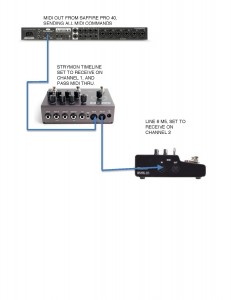I get a lot of question on what EXACTLY MIDI is. I can say “I have a MIDI controller here, and this is sending MIDI notes to here, and then I have this MIDI drum pad here, and that is sending a MIDI Program Change to here” and once I finish my sentence, I get these blank stares. So I thought I would simply MIDI to a few basic principles for those of you wanting to use it in your keyboard rigs, guitar rigs, loop rigs, etc.
What Does It Mean?
Musical Instrument Digital Interface
What Does It Do?
MIDI signal is simply an electronic protocol. There is absolutely no audio signal passed through a MIDI cable, it is simply for electronic devices to talk to each other. A basic MIDI cable will usually by a 5-pin male-to-male cable. But only three of the pins are usually connected.
When Was It Made?
In the musical world, MIDI is still relatively new, but is being used now in ways I doubt Bob Moog and Dave Smith, who developed and announced it in the early 80’s, would be able to imagine what it would be doing now.
So How Does It Work?
As I said, MIDI is simply a protocol through which messages are sent through electronic devices. In a keyboardist/multi-instrumentalists/programmers context, it is really useful. In my current rig, a Line 6 M5, and a Strymon Timeline. These all have MIDI IN capability. So how do I use them? Well, MIDI cables have the ability to carry 16 channels per separate and available midi hosts. So, in the diagram below, I send MIDI OUT from my Saffire Pro 40, to the MIDI IN, of the Strymon Timeline, then MIDI OUT of the Timeline to the MIDI IN of the M5 Using MIDI channels settings in the respective units, I am able to change presets, and programs, as well as tempo via one push of a button send a MIDI Program Change to each of these. One brilliant thing about Ableton, and these pedals that is really great is the MIDI Tempo Sync feature. So whatever tempo I assign to Ableton Live, it sends signal to sync the tap tempo of the respective pedals!
In the diagram, all of these parts are connected by MIDI cables. I am using Ableton Live to send MIDI commands out of the Saffire Pro 40, to the rest of these. Since a MIDI cable can carry 16 different channels of commands, there is no need for different MIDI output ports, all the different channel commands are running through one line of cable. So, I am able to talk with the pedals individually or at the same time as well as change tempo via the MIDI sync function in Ableton Live so all my tap tempos line up automatically.
*note: the Line 6 M5 like many other devices may have MIDI OUT but it will not pass incoming signal through it, otherwise known as MIDI THRU. A Midisolutions box, such as a Midisolutions Quadra, is a great MIDI Splitter for sending different signals to various devices if MIDI THRU is not an option.
More to come soon!


